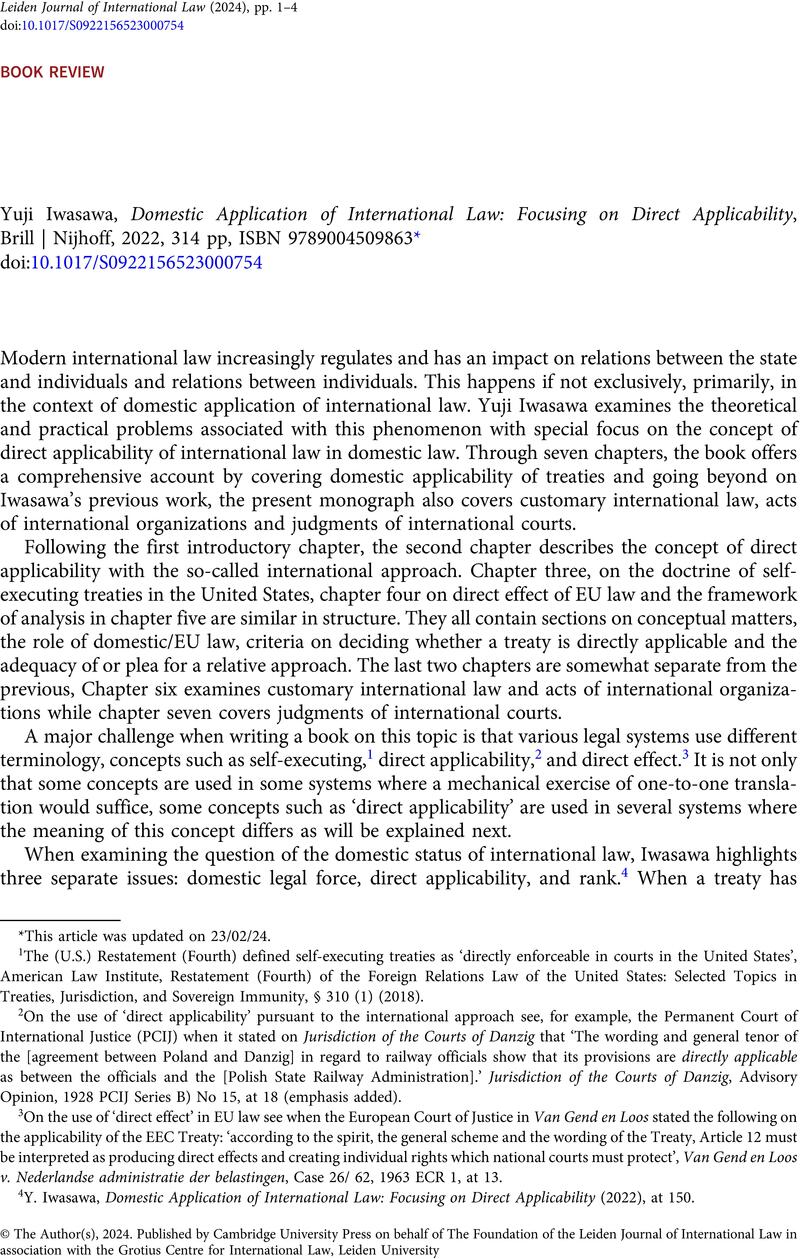No CrossRef data available.
Article contents
Yuji Iwasawa, Domestic Application of International Law: Focusing on Direct Applicability, Brill | Nijhoff, 2022, 314 pp, ISBN 9789004509863*
Review products
Published online by Cambridge University Press: 12 February 2024
Abstract

- Type
- Book Review
- Information
- Copyright
- © The Author(s), 2024. Published by Cambridge University Press on behalf of The Foundation of the Leiden Journal of International Law in association with the Grotius Centre for International Law, Leiden University
Footnotes
This article was updated on 23/02/24.
References
1 The (U.S.) Restatement (Fourth) defined self-executing treaties as ‘directly enforceable in courts in the United States’, American Law Institute, Restatement (Fourth) of the Foreign Relations Law of the United States: Selected Topics in Treaties, Jurisdiction, and Sovereign Immunity, § 310 (1) (2018).
2 On the use of ‘direct applicability’ pursuant to the international approach see, for example, the Permanent Court of International Justice (PCIJ) when it stated on Jurisdiction of the Courts of Danzig that ‘The wording and general tenor of the [agreement between Poland and Danzig] in regard to railway officials show that its provisions are directly applicable as between the officials and the [Polish State Railway Administration].’ Jurisdiction of the Courts of Danzig, Advisory Opinion, 1928 PCIJ Series B) No 15, at 18 (emphasis added).
3 On the use of ‘direct effect’ in EU law see when the European Court of Justice in Van Gend en Loos stated the following on the applicability of the EEC Treaty: ‘according to the spirit, the general scheme and the wording of the Treaty, Article 12 must be interpreted as producing direct effects and creating individual rights which national courts must protect’, Van Gend en Loos v. Nederlandse administratie der belastingen, Case 26/ 62, 1963 ECR 1, at 13.
4 Y. Iwasawa, Domestic Application of International Law: Focusing on Direct Applicability (2022), at 150.
5 Ibid., at 153–4, 277.
6 Ibid., at 162, 179, 180, 208.
7 Ibid., at 94, 231.
8 J. Winter, ‘Direct Applicability and Direct Effect: Two Distinct and Different Concepts in Community Law’, (1972) 9 Common Market Law Review 425, at 429.
9 For example, see the use of ‘directly applicable’ in the dispositif of Reyners v. Belgian State, Case 2-74, 1974 ECR 631, at 656.
10 See Iwasawa, supra note 4, at 94, 145.
11 Ibid., at 4–5.
12 Foster v. Neilson, 27 U.S. (2 Pet.) 253 (1829).
13 See Jurisdiction of the Courts of Danzig, supra note 2.
14 See Iwasawa, supra note 4, at 91, 94.
15 See Van Gend en Loos v. Nederlandse Administratie der Belastingen, supra note 3. However, the Court of Justice rather emphasized ‘the spirit, the general scheme and the wording of the EEC Treaty’ (at para. 5), the ‘objective of the EEC treaty’ (at 12), and not the intent of the parties.
16 See Iwasawa, supra note 4, at 48–9, 64, 84, 118, 162, 165, 177, 196–200, 224–5.
17 Q. Wright, ‘National Courts and Human Rights--The Fujii Case’, (1951) 45(1) American Journal of International Law 62, at 77.
18 See Iwasawa, supra note 4, at 3, 227.
19 Ibid., at 3, 151.
20 Ibid., at 3.
21 Prop. 2017/18:186, at 77, 85, 88–9 and Annex 1, at 119.
A correction has been issued for this article:
Linked content
Please note a has been issued for this article.


